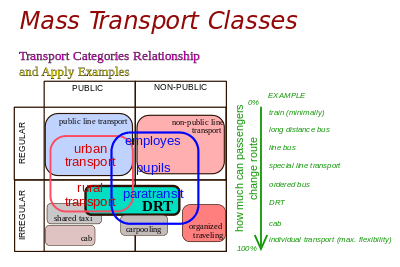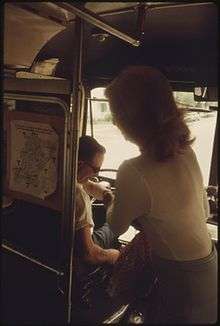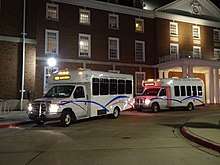Demand responsive transport
Demand-responsive transport, also known as demand-responsive transit (DRT), demand-responsive service,[1] Dial-a-Ride transit (DART)[2][3] or flexible transport services[4] is a form of shared private transport (or quasi-public) for groups travelling where vehicles alter their routes based on particular transport demand rather than using a fixed route or timetable.[5] These vehicles typically pick-up and drop-off passengers in locations according to passengers needs and can include taxis, buses or other vehicles.[6][7]

One of the most widespread types of demand-responsive transport (DRT) is to provide a public transport service in areas of low passenger demand where a regular bus service is not considered to be financially viable, such as rural and peri-urban areas.[8] Services may also be provided for particular types of passengers. One example is the paratransit programs for people with a disability. The provision of public transport in this manner emphasises one of its functions as a social service rather than creating a viable movement network.[9][10][11]
Definition
DRT can be used to refer to many different types of transport. When taxicabs were first introduced to many cities, they were hailed as an innovative form of DRT. They are still referred to as DRT in some jurisdictions around the world as their very nature is to take people from point-to-point based on their needs.[12][13][5]
More recently, DRT generally refers to a type of public transport. They are distinct from fixed-route services as they do not always operate to a specific timetable or route.[14] While specific operations vary widely, generally a particular area is designated for service by DRT. Once a certain number of people have requested a trip, the most efficient route will then be calculated depending on the origins and destinations of passengers.
Share taxis are another form of DRT. They are usually operated on an ad hoc basis but also do not have fixed routes or times and change their route and frequency depending on demand.[15]
Some DRT systems operate as a service that can deviate from a fixed route. These operate along a fixed alignment or path at specific times but may deviate to collect or drop off passengers who have requested the deviation.[1][16]
Operation
A DRT service will be restricted to a defined operating zone, within which journeys must start and finish. Journeys may be completely free form, or accommodated onto skeleton routes and schedules,[8] varied as required. As such, users will be given a specified pick-up point and a time window for collection.[8] Some DRT systems may have defined termini, at one or both ends of a route, such as an urban centre, airport or transport interchange, for onward connections.
DRT systems require passengers to request a journey by booking with a central dispatcher[8][14] who determines the journey options available given the users' location and destination.
DRT systems take advantage of fleet telematics technology in the form of vehicle location systems, scheduling and dispatching software and hand-held/in vehicle computing.[8][17]
Vehicles used for DRT services will usually be small minibuses, reflecting the low ridership, but also allowing the service to provide as near a door to door service as practical, by being able to use residential streets.[8] In some cases Taxicabs are hired by the DRT provider to serve their routes on request.
DRT schemes may be fully or partially funded by the local transit authority. As such, operators of DRT schemes may be selected by public tendering. Other schemes may be partially or fully self-funded as community centred not for profit social enterprises (such as a Community interest company in the UK). They may also be provided by private companies for commercial reasons; some conventional bus operating companies have set up DRT-style airport bus services, which compete with larger private hire airport shuttle companies.
Simulations of health and environmental effects
For a model of a hypothetical large-scale demand-responsive public transport system for the Helsinki metropolitan area, simulation results published in 2005 demonstrated that “in an urban area with one million inhabitants, trip aggregation could reduce the health, environmental, and other detrimental impacts of car traffic typically by 50–70%, and if implemented could attract about half of the car passengers, and within a broad operational range would require no public subsidies”.[18]
Licensing
DRT schemes may require new or amended legislation, or special dispensation, to operate, as they do not meet the traditional licensing model of authorised bus transport providers or licensed taxicab operators. The status has caused controversy between bus and taxi operators when the DRT service picks up passengers without pre-booking, due to the licensing issues.[19][20] Issues may also arise surrounding tax and fuel subsidy for DRT services.
Effectiveness
Ridership on DRT services is usually quite low (less than ten passengers per hour), but DRT can provide coverage effectively.[21][22]
Current DRT systems by country
Australia
- CoastConnect, first-mile / last-mile Demand Responsive Transport service in Woy Woy, New South Wales,[23] operated by Community Transport Central Coast Limited and Liftango
- Kan-go, Demand Responsive Transport service in Hervey Bay, Queensland[24] and Toowoomba, Queensland[25]
- SmartLink, Demand Responsive Transport service in Blue Mountains.[26]
- Skybus hotel transfer service in Melbourne, Victoria.[27]
- Telebus in Melbourne, Victoria providing demand-responsive bus services to some outer suburbs of the metropolitan area since the 1970s.[28][29]
Austria
- RufbusLinie 326 Leopoldschlag – Summerau – Freistadt[30]
Canada
- Belleville, Ontario – BT Let's Go, operated by Belleville Transit, replaces fixed route night bus services with an on-demand transit service. This provides stop-to-stop scheduled pick-ups and drop-offs requested by riders through a web-based application. Buses are dynamically routed to riders in real-time by an autonomous algorithm.[31][32]
- Winnipeg, Manitoba – Dial-a-Ride Transit, operated by Winnipeg Transit, replaces regular fixed transit route service in three neighbourhoods during low-use hours and provides door-to-door transit service in one inner-city neighbourhood during daytime hours.[33]
Hong Kong
Red minibuses which serve non-franchised routes across the country, depending on routes, allow passengers to reserve their seats by phone such that operators and drivers are able to know where passengers are and how many there are in deploying their vehicles.[34][35]
Czech Republic
- Radiobus – has operated across the country since 2004. Since 2011, it has been part of the general public transport system to supplement the existing system during times of low demand. It uses fixed timetables, but vehicles only operate when called by passenger.[36]
- DHD – has operated since 2003. Its primary purpose was for collecting workers from sparsely-populated rural areas. DHD provides bookings and administrative support, however, the buses themselves are operated by several local transport companies.[37]
Germany
- Braunschweig, Lower Saxony – Anruflinien-Taxi (ALT) and Anruflinien-Bus (ALB) [38]
- Berlin – Allygator Shuttle.,[39] Clevershuttle, BerlKönig
- Cologne – AnrufLinienFahrt (ALF), an on-demand minibus service that operates in predominantly rural areas of the city.[40]
- Dresden – Anruf-Linien-Bus Verkehrsgesellschaft Meißen[41]
- Duisburg – myBUS[42]
- Elbe-Elster – Anruf-Linienbus, a DRT bus service operated by the regional public transport authority in Herzberg, Sonnewalde, Umland and Finsterwalde[43]
- Hamburg – MOIA (Volkswagen AG#Mobilitätsdienstleistungen)
- Freyung, Bavaria – FreyFahrt[44]
- Munich – IsarTiger
- Rostock – REBUS = Regional Bus Rostock
Iceland
Public transport authority in the Icelandic capital of Reykjavik and the surrounding municipalities. Manages public bus transport and disabled transport, but does not have its own vehicles. About 1300 enquiries and thousand trips a day. Uses 60 vehicles and 10–20 more for school transport for children with special needs. For more see http://eu-en.trapezegroup.com/case-study/straeto-iceland]
Italy
Following some pioneering DRT schemes implemented in the 1980s, a second wave of systems were launched from the mid 1990s. There are now DRT schemes in urban and peri-urban areas as well as in rural communities. Operated by both public transport companies and private service providers, the DRT schemes are offered either as intermediate collective transport services for generic users or as schemes for specific user groups. DRT schemes operate in major cities including Rome, Milan, Genoa, Florence, and in several mid- to small-size towns including Alessandria, Aosta, Cremona, Livorno, Mantova, Parma, Empoli, Siena, and Sarzana.
- AllôBus and AllôNuit, Demand Responsive Transport service in Aosta/Aoste
- DrinBus, Demand Responsive Transport service in Genoa[45]
- PersonalBus, Demand Responsive Transport service in Florence
- ProntoBus, Demand Responsive Transport service in Livorno and Sarzana
- EccoBus, Demand Responsive Transport service in Alessandria
- StradiBus, Demand Responsive Transport service in Cremona
- Radiobus, Demand Responsive Transport service in Milan
Japan
More than 200 of the 1700 local governments in Japan have introduced DRT public transport services.
Luxembourg
Poland
The first ever demand responsive transport scheme in Poland – called Tele-Bus – has been operated since 2007 in Krakow by MPK, the local public transport company (see also Tramways in Krakow).[48][49]
Sweden
Regional transport authority in Västra Götaland in southwestern Sweden is responsible for all public transport and for transport offers to citizens with special needs. This is an example of DRT used for people with special needs (paratransit).[50]
Switzerland
DRT services have operated in some sparsely populated areas (under 100 p/km2) since 1995. PostBus Switzerland Ltd, the national post company, has operated a DRT service called PubliCar, formerly also Casa Car.[51]
United Kingdom
Under the existing UK bus operating regulations of 1986, some DRT schemes were operating, allowed by the fact they had a core start and finish point, and a published schedule.[52] For England and Wales in 2004, the regulations concerning bus service registration and application of bus operating grants were amended, to allow registration of fully flexible pre-booked DRT services.[52] Some services such as LinkUp only pick up passengers at 'meeting points', but can set down at the passenger's destination.
- ArrivaClick (Kent and Merseyside)
- Cango (Hampshire)
- Connecting Communities / Suffolk Links (Suffolk)
- Connect2Wiltshire (Wiltshire)
- Go2 (Sevenoaks), DRT services implemented during the Covid-19 pandemic with app provided by ViaVan.
- LinkUp (Tyne & Wear) (Closed 2011)
- CallConnect (Lincolnshire)
- London Dial-a-Ride
- Ring'n'Ride (Strathclyde)[53]
- Nippy Bus (Somerset)
- Demand Responsive Transport (Aberfoyle)[54]
- Dengie DaRT 99, connecting passengers from the Maldon district with Broomfield and St Peter's Hospitals[55]
- Scarborough Dial A Ride (North Yorkshire)[56]
- Kent Karrier (Kent)[57]
- Slide Bristol (real-time service by Padam)
- Snap provides on-demand long-distance coach services.
United States


The large majority of 1,500 rural systems in the US provide demand-response service; there are also about 400 urban DRT systems.[58]
California
- Demand-Responsive Van Service,[14]
- Demand-Response Shuttle, Don Edwards San Francisco Bay National Wildlife Refuge[14]
- Demand-Responsive Transit, Redwood National and State Parks[14]
Colorado
- Call-n-Ride service, Regional Transportation District, Denver[59]
Illinois
- Call-n-Ride, Pace Bus, Chicago metropolitan area[60]
- Safe Rides, Champaign-Urbana Mass Transit District, Champaign-Urbana metropolitan area (evening and overnight service only)
Maryland
- Ride On Flex, Ride On, Montgomery County[61]
New York
- Access-A-Ride, Metropolitan Transportation Authority, New York City
- Bee-Line Paratransit, Bee-Line Bus System, Westchester County
South Carolina
Washington State
- Dial-a-Ride Transit, Community Transit, Snohomish County[63]
- Metro Access, King County Metro, King County[64]
- Finley Service, Ben Franklin Transit, Tri-Cities, Washington[65]
Washington DC
- MetroAccess, WMATA, Washington, DC
See also
- Open data
- Paratransit
- Hail and Ride
- Share taxi
- Microtransit
External links
Notes and references
- NTD Glossary Archived 2013-11-13 at the Wayback Machine US National Transit Database
- Winnipeg Transit Archived 2009-07-08 at the Wayback Machine
- King County Transit
- CONNECT is a Coordination Action in the Sustainable Development Thematic Area of the European Union's 6th Framework Program, successfully ended on December 2005.
- "What is Demand-Responsive Transport?" (PDF). Transport for Communities. Retrieved 7 January 2019.
- Synopsis of DRT European Commission Directorate-General for Energy and Transport
- Brake, Jenny; Nelson, John D.; Wright, Steve (December 2004). "Demand responsive transport: towards the emergence of a new market segment". Journal of Transport Geography. 12 (4): 323–337. doi:10.1016/j.jtrangeo.2004.08.011.
- www.drtbus.co.uk Archived 2008-03-19 at the Wayback Machine What is DRT?
- "Social benefits of buses: valuing the social impacts". GOV.UK. Retrieved 7 January 2019.
- "Integrated Public Transport Service Planning Guidelines" (PDF). Transport for New South Wales. Retrieved 7 January 2019.
- Mees, Paul (2000). A very public solution : transport in the dispersed city. Melbourne: Melbourne University Press. ISBN 9780522848670.
- "Demand Responsive Transport (DRT)". Stirling Council. Retrieved 7 January 2019.
- "On-demand Transport: A discussion paper for future innovation" (PDF). www.transport.wa.gov.au. The Government of Western Australia. Retrieved 7 January 2019.
- Demand-Response Transit Service Archived 2008-09-24 at the Wayback Machine The Central Federal Lands Highway Division, US department of Transportation
- Grava, Sigurd (September 2002). Urban transportation systems : choices for communities. McGraw-Hill. ISBN 9780071384179.
- "Telebuses". www.ptv.vic.gov.au. Public Transport Victoria. Retrieved 7 January 2019.
- "Using smart technologies to revitalize demand responsive transport". Journal of Intelligent Transportation Systems, Volume 1, Issue 3 1994 , pages 275 – 293.
- Jouni T Tuomisto, Marko Tainio: An economic way of reducing health, environmental, and other pressures of urban traffic: a decision analysis on trip aggregation, BioMed Central, November 25, 2005
- Shuttle faces probe into 'illegal fares' Archived 2007-11-02 at the Wayback Machine Edinburgh Evening News, 13 September 2007
- Row over Edinburgh Airport shuttle service Archived 2007-12-24 at the Wayback Machine UK-Airport-News.info, 15 October 2007
- A Guide for Planning and Operating Flexible Public Transportation Services
- Human Transit: Can a "flexible route" solve the problem of low ridership due to low density? Archived 2015-09-06 at the Wayback Machine
- "CoastConnect". Transport for NSW. Community Transport Central Coast Limited. Retrieved 28 October 2019.
- "qconnect Hervey Bay Kango Timetable" (PDF). Queensland Department of Main Roads and Transport. Qconnect. Archived from the original (PDF) on 1 March 2017. Retrieved 17 January 2019.
- "Kan-go Toowoomba". Translink. State of Queensland. Retrieved 17 January 2019.
- SmartLink Community Transport by Great Community Transport
- "SkyBus – SkyBus Link – Free city hotel shuttle". Skybus. Retrieved 17 January 2019.
- "Telebuses". ptv.vic.gov.au. Public Transport Victoria. Retrieved 17 January 2019.
- Wang, Fei. "MEETING OLDER PERSONS' MOBILITY AND ACCESS NEEDS – A RE-THINK ON PUBLIC TRANSPORT" (PDF). Department of Infrastructure, Victoria. Retrieved 17 January 2019.
- "Gemeinde Rainbach im Mühlkreis, Gemeinde Informationen für Einwohner – Fahrpläne". rainbach.at. Retrieved 17 January 2019.
- "How Belleville, Ont., is using technology to tackle transit troubles". CBC. Retrieved 17 January 2019.
- "Pantonium On-Demand Transit". btletsgo.ca. Retrieved 17 January 2019.
- "About DART". Winnipeg Transit. Retrieved 17 January 2019.
- "RMB Route: Aberdeen – Shek Tong Tsui | www.16seats.net". www.16seats.net. Retrieved 17 January 2019.
- "RMB Route: Sai Kung – Causeway Bay | www.16seats.net". www.16seats.net. Retrieved 17 January 2019.
- "RadioBUS". www.audis.cz. Audis Bus. Retrieved 17 January 2019.
- "Dispeink hromadn dopravy". www.hromadnadoprava.cz. DHD.
- "Braunschweiger Verkehrs-GmbH – Anruflinien-Taxi". www.verkehr-bs.de. Retrieved 17 January 2019.
- "Shuttle service makes it snappy". Smart Cities World. 2 February 2018. Retrieved 17 January 2019.
- "AnrufLinienFahrt (ALF) – anrufen oder online buchen und wir kommen". www.mvg-online.de. MVG. Retrieved 17 January 2019.
- "Anruf-Linien-Bus Verkehrsgesellschaft Meißen" (in German). Retrieved 17 January 2019.
- "myBUS – jetzt mit gratis WLAN". www.dvg-duisburg.de (in German). DVG-Duisburger Verkehrsgesellschaft. Retrieved 17 January 2019.
- "Neu im Angebot: Anruf-Linienbus". Lausitzer Rundschau. LAUSITZER RUNDSCHAU. Retrieved 17 January 2019.
- ""freYfahrt": ÖPNV nach Bedarf und via Internet bestellbar – Wirtschaft-News" (in German). Süddeutsche.de. Retrieved 17 January 2019.
- DrinBus service "AZIENDA MOBILITA' E TRASPORTI SpA" Check
|url=value (help) (in Italian). ADT. Retrieved 17 January 2019. - "Flexibus". Sales-Lentz. Retrieved 17 January 2019.
- Laura Ducoli, Lisa (8 March 2018). "Kussbus: Redefining the daily commute". luxtimes.lu. Luxembourg Times. Retrieved 17 January 2019.
- "MPK SA in Cracow / Tele-Bus". MPK. 28 May 2011. Archived from the original on 28 May 2011. Retrieved 17 January 2019.
- "Tele-Bus Kraków". Vimeo. MPK.
- "Multiple forms of transport in just one work-stream". www.trapezegroup.eu (in Swahili). Retrieved 17 January 2019.
- "PubliCar". www.postauto.ch. Retrieved 17 January 2019.
- Registration of Flexible Local Bus Services and Related BSOG Regulations UK Department for Transport
- "Archived copy". Archived from the original on 2009-03-25. Retrieved 2009-04-01.CS1 maint: archived copy as title (link)
- "Archived copy". Archived from the original on 2010-07-29. Retrieved 2010-10-18.CS1 maint: archived copy as title (link)
- News and Events Archived 2012-04-26 at the Wayback Machine
- Home
- "Archived copy". Archived from the original on 2013-01-18. Retrieved 2012-10-28.CS1 maint: archived copy as title (link)
- Guidebook for Rural Demand-Response Transportation: Measuring, Assessing, and Improving Performance. http://onlinepubs.trb.org/onlinepubs/tcrp/tcrp_rpt_136.pdf: document of The Transportation Research Board. p. 100.CS1 maint: location (link)
- http://www.rtd-denver.com/callNRide.shtml
- http://articles.chicagotribune.com/2011-11-04/news/ct-met-pace-call-n-ride-20111104_1_call-n-ride-fixed-route-bus-routes
- "Ride On Flex". www.montgomerycountymd.gov. Retrieved 2019-06-06.
- "Tel-A-Ride | CARTA". www.ridecarta.com. Retrieved 2019-06-06.
- "DART". Retrieved 2019-06-06.
- "Access Transportation". King County Metro. May 31, 2019. Retrieved June 6, 2019.
- "Finley". Ben Franklin Transit. Archived from the original on June 16, 2012. Retrieved May 19, 2013.